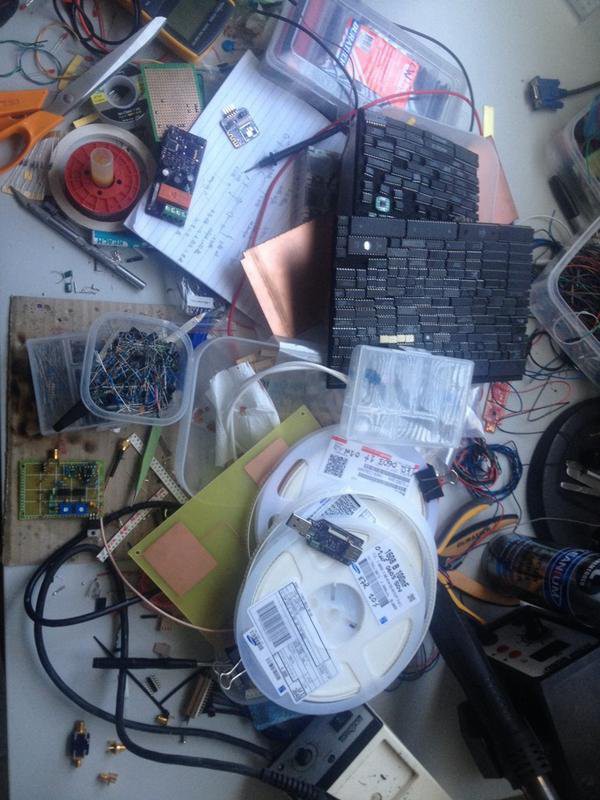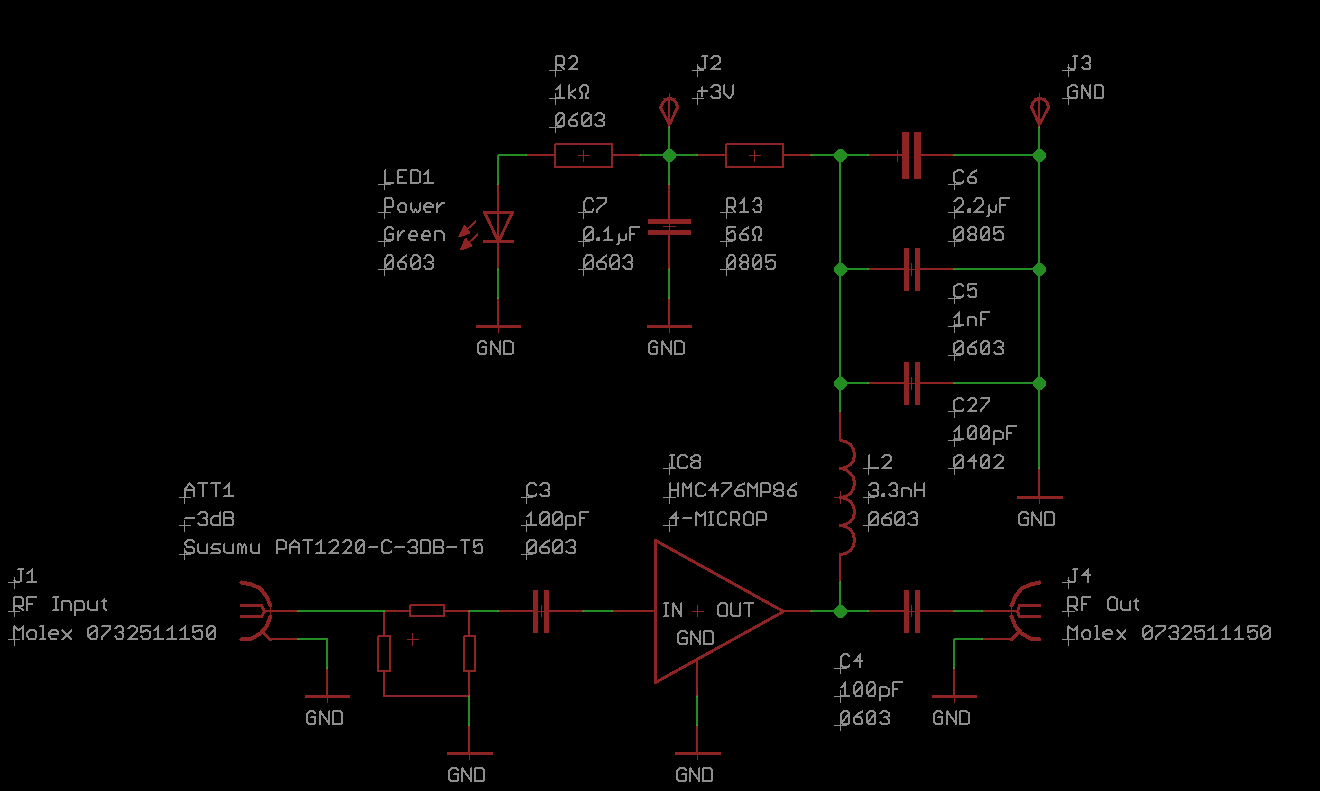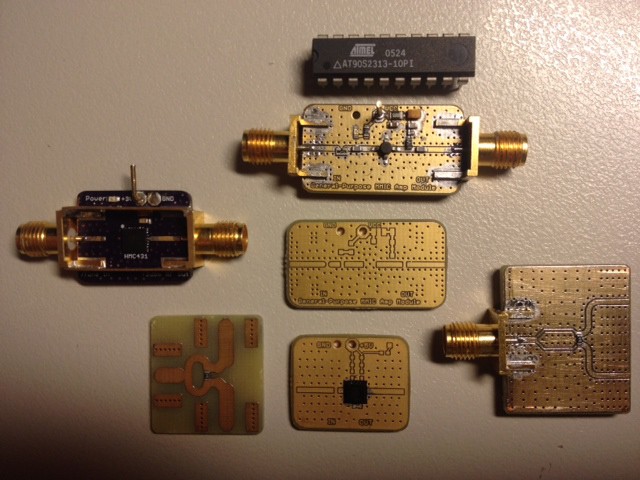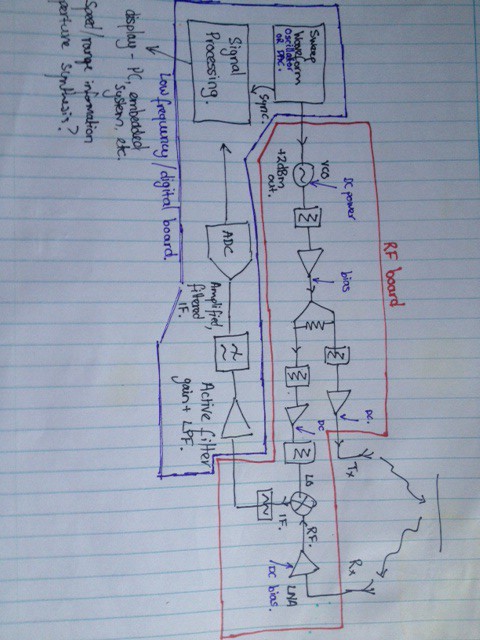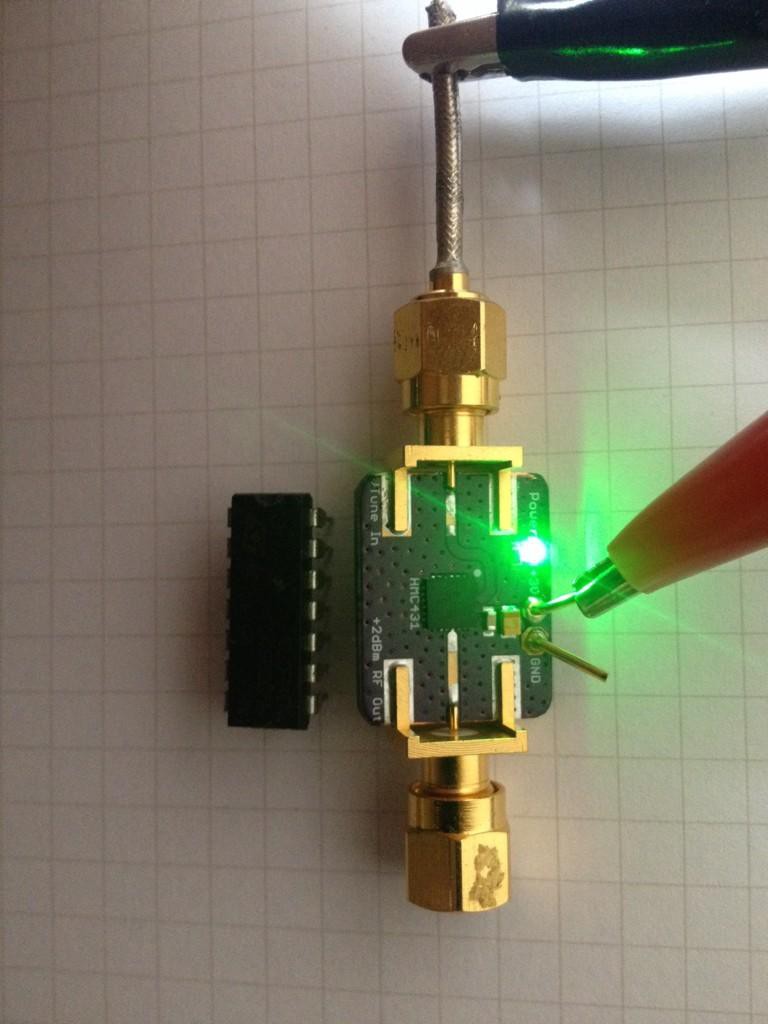-
Vision with microwaves
12/22/2014 at 11:32 • 0 commentsIt needs a bit of filtering and frequency domain analysis, Fourier stuff, to extract the information you want, eg range, or speed, or imaging, and discard the stuff you don't. But that's mainly a software problem - there's now an analog output ready for the computer.
Sure, I can do basic proximity detection and rangefinding at the bench scale with existing ultrasound or infrared sensors, but this is so much more interesting.
-
Some new videos
12/22/2014 at 11:28 • 0 commentsTrying a video on the iPad for the first time, so sorry if the camera is a bit clumsy. I think it's actually a little bulky and awkward compared to using a phone.
Here the voltage on the varactor is held constant, without any modulation, so the output frequency isn't being modulated.
The only thing that comes out from the mixer is the frequency offset of the Doppler-shifted RF reflected back from a target that is moving. In this mode, spatial mapping or rangefinding is impossible, but measuring a target's speed, like a police radar, is possible.
A stationary target produces no signal, no matter how close it is or what its radar cross-section is like. Much like the Tyrannosaurus that eats Gennaro in Jurassic Park, it can only "see" movement.
And I just realised there's a typo in the title.
-
New video is up!
09/29/2014 at 07:00 • 0 commentsNOTE: This is an 8-minute video, I know it is slightly longer than the 5 minutes requested by the THP judges. I think you'll still get some valuable substance and overview of the project work thus far if you stop watching at the 5 minute mark... so hopefully they are not too strict about an extra couple of minutes. Hope that's OK :)
Please enjoy, and feel free to let me know if you have any comments or questions! :) -
Productive day.
09/29/2014 at 06:59 • 0 comments
See, you can see just how productive my desk is today! (I swear it's not usually this bad!). I guess you could call this a behind-the-scenes "how it's made" sneak-peek.![]()
-
Gain block schematic
09/29/2014 at 06:54 • 0 comments
This is the schematic of my HMC476 "building block" module for prototyping. I'm going to have everything on GitHub for public open-source consumption shortly, but right now, you can enjoy a pic :) Please do comment if you have any questions. :)![]()
-
New video coming!
09/29/2014 at 06:45 • 0 commentsIn fact I am uploading it right now! :)
-
Where's the software?
08/21/2014 at 04:36 • 0 commentsIf you're interested in software, you might be wondering how much software I have for this project, or where you can check it out. I've just put some code up on GitHub, you can check it out by following the sidebar link.
Truth be told, there isn't much software right now.
Part of the reason for this is that I'm focussing on the relatively tricky microwave electronics first, and getting the RF hardware platform working. Another reason is that some people (Greg Charvat, for example) have already created some fantastic signal processing software tools and shared their contributions with the world.
I've put up my quick SPI test code, using an Arduino to drive a Microchip SPI DAC to generate a triange-wave modulation signal (this is amplified, as previously discussed, into an 0-10V signal.) However, this was just a quick experiment and it is unlikely that the finished product will use an ATmega328 microcontroller or Arduino-compatible bootloader. I'll continue to share any quick little software tests, tools or scripts as they come along.
Another thing I'm currently working on is to take the MATLAB signal processing and visualisation scripts provided by Greg Charvat and the MIT/Lincoln Lab folks, and to tweak these for the best match to my hardware characteristics - and to replace the use of MATLAB with free software tools, since MATLAB isn't really the cheapest, most accessible choice. As work progresses, I'll continue to share these changes and new code that is written. -
Bits and pieces
08/15/2014 at 13:02 • 1 commentHere are a few little components I've been working on lately - reusable, modular, general-purpose building blocks for various RF experiments and R&D.
- HMC431 VCO module with shielded can (top of can not shown)
- A simple breakout board for SOT86/Micro-X RF gain blocks. (Top centre) This could be used with various MMIC devices in that package, from RFMD, Hittite, Mini-Circuits or various other manufacturers, they're all pretty similar. This board provides coupling capacitors, bias tee, power indicator LED, current limiting resistor in the MMIC supply rail, and a few decoupling capacitors. The passive values can easily be changed to suit different devices, so it's a generally usable module. An input attenuator is provided on this board so that the output power can be kept within the amplifier's linear region if the input power is too large.
- HMC717 LNA breakout board (bottom centre).
- Two different Wilkinson dividers, one of which uses a coplanar waveguide architecture (with top groundplane) and one of which uses more a microstrip approach (no top copper pour, fatter tracks compared to CPWG for the same given impedance.) We'll see if they exhibit any performance difference.
- 20-DIP chip provided for scale reference.
I made these boards with no solder mask at all - for a few reasons.
(a) Because the thin dielectric layer of solder mask between the metal and the air introduces a slight error (admittedly it is small) into the physics (for impedance and width calculations etc) because it is not accounted for in the model.
(b) To see if the board fab would have any issues with it. (No.)
(c) Because it makes it easy to see where all the signal traces are, makes it easy to shunt extra components between the signal tracks and the groundplane (eg. to add extra bypass capacitors), to cut the tracks and hack the boards in other ways, eg. adding extra attenuation, if the need arises.
(d) Because it looks good. OOH SHINY. The slight disadvantage is that the solder looks slightly "messy" (although there aren't any shorts) where it spills across the ENIG groundplane.
I did put a small region of solder mask underneath the 16-pin LNA, because with the 16-pin 0.5mm pitch QFN device I wanted to ensure it soldered successfully without any shorts or problems. (I haven't tested it yet, but to visual inspection it's good.)
Mixer boards are coming, but they haven't arrived yet.![]()
-
System block diagram
08/08/2014 at 05:50 • 0 commentsSo, you like block diagrams? Here, have a quick sketch of a diagram. :)
(Note: the attenuator before the mixer LO port doesn't need to be there; that's a mistake.)
![]()
-
VCO devboard / module
08/05/2014 at 03:44 • 0 commentsThis is a little dev board / module with the HMC431 VCO on board. 14-DIP chip for scale.
You could use this with any of the other Hittite VCOs with the same package and pinout to suit a different frequency range as needed, such as the HMC385.![]()
Simple, low-cost FMCW radar
A basic radar system makes radar accessible at low cost for experiments with rangefinding & navigation of autonomous aircraft or spacecraft.
